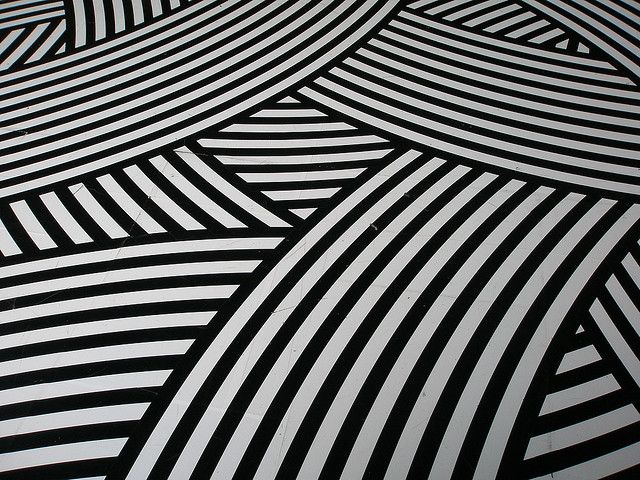
Decoration of floors with tape and vinyl tapes
What would you say if the flooring inYour house was as unusual, bright and original as at exhibitions and museums of contemporary art in Europe and the US? And this is quite feasible, and you can make such a floor with your own hands! But first let's see how the floor decorates the famous Scottish designer Jim Lambie for public places, private shops and houses all over the world.  Jim Lambie as a modern artist has earned himselfwide fame in the early 2000's, when he first used a sticky vinyl tape of various colors as the design of the sexes. The installation on the floor Touch Zobop (2003) has become a business card of the designer, and bright stripes and geometric patterns - recognizable handwriting.
Jim Lambie as a modern artist has earned himselfwide fame in the early 2000's, when he first used a sticky vinyl tape of various colors as the design of the sexes. The installation on the floor Touch Zobop (2003) has become a business card of the designer, and bright stripes and geometric patterns - recognizable handwriting.  The artist painstakingly and scrupulously creates suchcheerful colorful or strict black-and-white ornaments made of scotch according to the scheme developed by him, which corresponds to the geometry of the room. The strips of vinyl tape are glued to the floor first along the perimeter of the space and until the pattern reaches the center. Such a decorative reception seems to fill the space, while leaving it empty.
The artist painstakingly and scrupulously creates suchcheerful colorful or strict black-and-white ornaments made of scotch according to the scheme developed by him, which corresponds to the geometry of the room. The strips of vinyl tape are glued to the floor first along the perimeter of the space and until the pattern reaches the center. Such a decorative reception seems to fill the space, while leaving it empty.  To create such floor installations, you canuse special adhesive tape-tape for signal marking of hazardous areas in the industry, barriers, columns, marking the lanes of workers and transport of storage facilities, areas of sports grounds, etc. This vinyl tape has a number of advantages and is perfectly suitable for such a large-scale project. Due to the elastic base, the vinyl tape perfectly fits even to uneven surfaces, does not bend at the edges, does not peel off over time, and also allows to give a curved shape. Vinyl is resistant to moisture, abrasion, abrasion, therefore it will last long even in high-capacity rooms.
To create such floor installations, you canuse special adhesive tape-tape for signal marking of hazardous areas in the industry, barriers, columns, marking the lanes of workers and transport of storage facilities, areas of sports grounds, etc. This vinyl tape has a number of advantages and is perfectly suitable for such a large-scale project. Due to the elastic base, the vinyl tape perfectly fits even to uneven surfaces, does not bend at the edges, does not peel off over time, and also allows to give a curved shape. Vinyl is resistant to moisture, abrasion, abrasion, therefore it will last long even in high-capacity rooms.  Whether it is possible to make such registration of floors thehands in the apartment? Of course! Think in advance the pattern, sketch his sketch on a sheet of paper or spill the floor. The surface of the floor can be painted, it can also be plain linoleum. Then start gluing tapes around the perimeter of the room to the center or, conversely, from the center to the walls. By the way, the walls can also be decorated using this "striped" technique. Well, a few more examples of the work of designer Jim Lambie for creative inspiration - more.
Whether it is possible to make such registration of floors thehands in the apartment? Of course! Think in advance the pattern, sketch his sketch on a sheet of paper or spill the floor. The surface of the floor can be painted, it can also be plain linoleum. Then start gluing tapes around the perimeter of the room to the center or, conversely, from the center to the walls. By the way, the walls can also be decorated using this "striped" technique. Well, a few more examples of the work of designer Jim Lambie for creative inspiration - more. 













